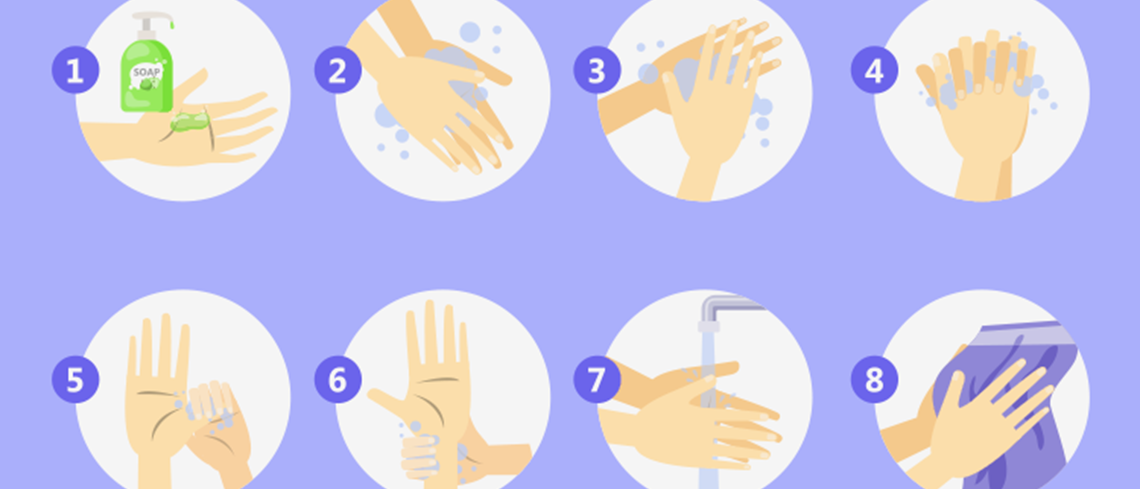You need to know these hand washing steps for a healthy you
According to the Centers for Disease Control and Prevention (CDC), handwashing is one of the most effective ways to prevent bacterial and viral infections and diseases.
Your hands accumulate dirt, dust, germs, bacteria, and other impurities throughout the day by touching surfaces and objects. The same contaminated hands are the prime reason for the spreading of various illnesses.
Regular handwashing can limit the transfer of microbes, such as bacteria and viruses. However, many people do not wash their hands properly or long enough to eliminate the germs.
In this article, we’ll look at the correct handwashing steps you must follow to ensure that your hands are free of harmful microorganisms that pose serious risks to your health.
Why should you focus on effective handwashing?
You must know how to wash your hands simply because it helps you effectively remove germs from your hands.
Germs are veterans when it comes to hiding - see where else they can hide? If they are not kicked off your body, they will strike when the time is right, and what’s the result? You get ill.
You must wash your hands to stop this from happening, so it is important to know if you are doing it right. As we take home care seriously, personal care should also be considered equally important.
Proper hand washing is necessary to reduce the risk of
- Coronavirus (Covid-19)
- Cold and flu
- MRSA
- Eyes, nose, and skin infections
- Diarrhea
When to wash your hands?
Washing hands correctly breaks the outermost layers of bacteria and viruses and ultimately kills them.
Now when should you wash your hands? Although you should wash your hands frequently. Here are some instances where you must always wash your hands:
Before and after:
- Preparing food
- Eating food or drinks
- Exposed to someone with an infectious disease
- Visiting public places such as hospitals, parks, schools, libraries, etc.
- Treating any cut, burn, or wound
- Using public transportation
- Touching frequently touched surfaces or objects that
After:
- Using toilet
- Coughing, sneezing, or blowing your nose
- Touch visibly dirty surfaces or when there’s visible dirt on your hands
- Change diapers or clean bodily waste off others
- Touch or handle garbage
- Touch animals, animal feed, or waste
How to wash your hands properly?
Knowing the following hand washing steps guarantees a healthy you and society:
- First, wet your hands with clean and running water (preferably warm).
- Next, apply enough antibacterial soap or antibacterial liquid handwash to cover every surface of your hands.
- Next, create a lather and rub it on your hands thoroughly.
- Next, scrub your palm, fingertips, fingernails, and wrists together.
- Continue this process for at least 20 seconds.
- Finally, rub the back of each hand.
- Rinse with clean and running water.
- Eventually, dry your hands and wrists with a clean towel, or let them air dry.
Different types of handwashing
There are different types of handwashing, including:
Routine or social
This handwashing involves soap and water, ideal for removing visible dirt after using the toilet and preparing food, and lasts a few seconds.
Antiseptic
This handwashing uses water and antimicrobial soap. It removes or destroys microbes on the skin.
Medical professionals may use this method before touching a high-risk patient or after contact with someone with an infection.
Surgical
Before all surgical procedures, medical professionals perform this handwashing involving water and antiseptic soap. It lasts for at least 2 minutes.
What should you do if soap and water aren’t available?
When soap and water aren’t available, disinfecting your hands with hand sanitizer or antibacterial multiuse wipes can be a viable option.
Like handwashing, the effectiveness of hand sanitizers depends on using the right technique.
To apply hand sanitizer properly, follow these steps:
- Apply 3 to 5 mL (2/3 to 1 teaspoon) in your palm.
- Rub vigorously, making sure to rub the product all over the surfaces of your hands and between your fingers.
- Rub for about 25 to 30 seconds until your hands are completely dry.
FAQs
Why is hand hygiene important?
Hand hygiene is essential for various diseases and infection prevention and control. For example, good hand hygiene will drastically reduce the risk of the common cold, flu, food poisoning, and other infectious diseases being passed from person to person.
Does it matter what soap you use to wash your hands?
You can use any bar soap or liquid soap to wash your hands as long as it contains antibacterial ingredients to kill germs and bacteria.
How many pumps of liquid handwash should you use?
One or two pumps of liquid handwash should suffice. However, more soap doesn't necessarily mean clean. Rub your hands together thoroughly to create enough lather to cover your whole hand – including fingers, the back of your hands, and even under your nails if you can.
